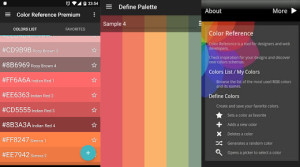In my previous tutorial, I discussed how to develop Android apps in C or C++ using the Native Development Kit. In this tutorial, I’ll introduce how to use C or C++ together with Objective-C in iOS. Unlike Android which needs a special API (the NDK) to support native development, iOS supports it by default. C or C++ development is more straightforward with iOS because of a feature called ‘Objective-C++’. I’ll discuss what Objective-C++ is, its limitations and how it’s used for building iOS apps.
What Is Objective-C++?
Objective-C++ may sound like a new programming language, but it’s not. It’s a combination of two languages, Objective-C and C++. Apple provides Objective-C++ as a convenient mechanism for mixing Objective-C code with C++ code.
Objective-C is close to C but with object-oriented features implemented as a thin layer on top of C. It’s a strict superset
of C which makes any C code a valid Objective-C program.
Even though Swift is now the recommended language for developing iOS apps, there are still good reasons to use older languages like C, C++ and Objective-C. Despite the quick rise of Swift, Objective-C is still the dominant language on iOS because of the sheer number of existing apps and libraries already created with it.
One reason to use Objective-C is to port an existing C/C++ program written for another platform to iOS. Developing cross-platform apps using C or C++ is possible with some careful planning. Despite Swift being open source, it’s not yet fully supported other platforms. Another use case is the ability to leverage existing native code libraries that are already available. This is one of the most important reasons to still use C/C++/Objective-C for iOS apps.
Using Objective-C++
The final project for this tutorial can be found on GitHub.
Create the Project
Open Xcode and choose Create a new Xcode project.
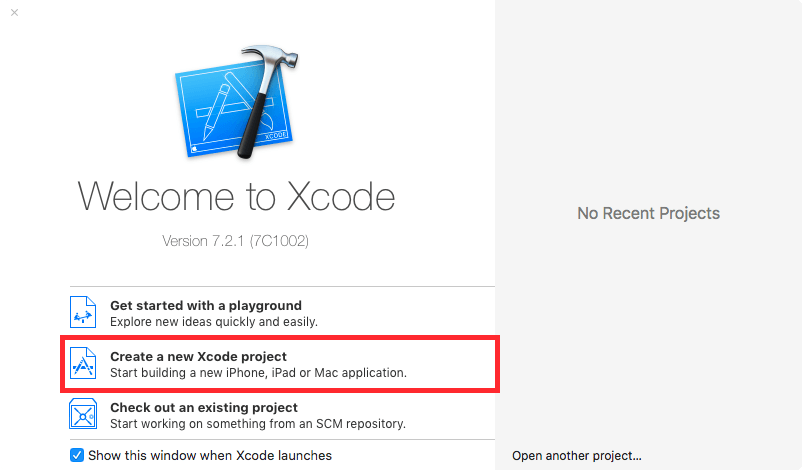
In the template selection screen, choose Single View Application from the iOS Application tab and click Next.
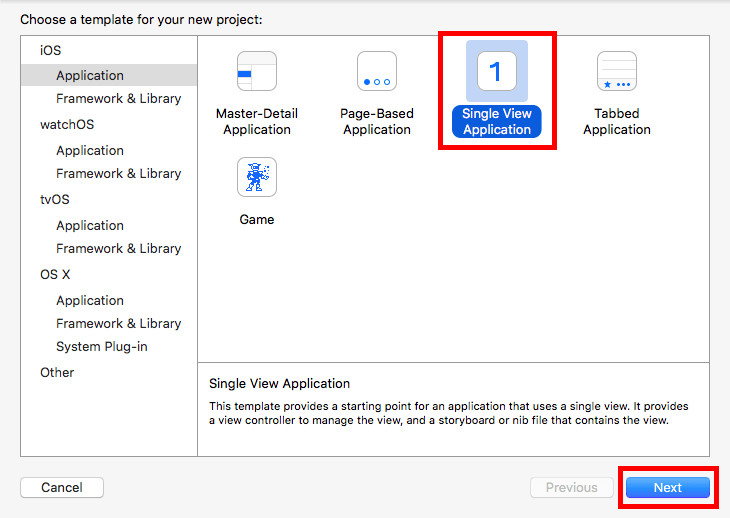
In the project options screen, name the product HelloCpp. Enter your organization and organization identifier in reverse domain name style.
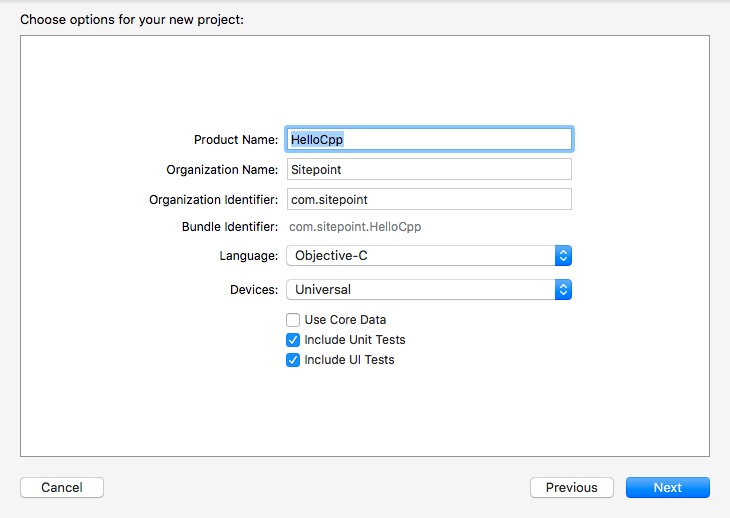
Because it’s not really a language, there’s no option to create an Objective-C++ project. What’s available is either Objective-C or Swift. For this project, choose Objective-C. Leave the other options as they are and click Next and choose a folder to save the project.
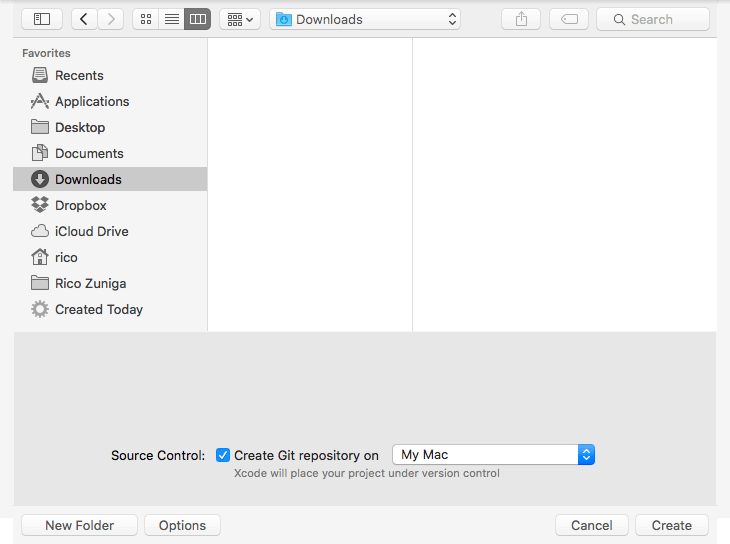
C++
Time to add some C++ code. If this is your first time with C++, check out this tutorial on the language. Look at the Project Navigator pane on the left. Most of the files end with either an .h or .m. Those that end with .h are header files while those with .m are Objective-C source files.
Create a C++ class that will be called from an Objective-C file. Create a new file using the File -> New -> File… menu item or press ⌘ + N. In the file template window that appears, select iOS -> Source -> C++ File and click Next.
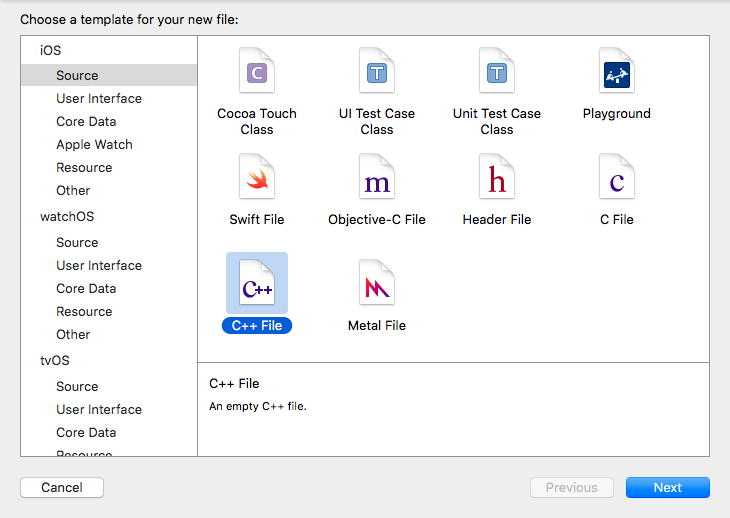
Name the file Greeting, keep the Also create a header file box checked and click Next. Save the file inside the HelloCpp folder.
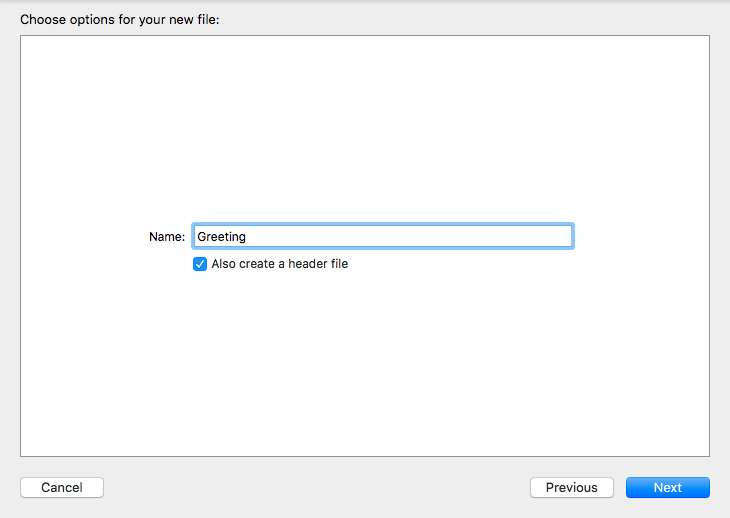
The project’s structure should now look like the following. Feel free to drag files around to improve the arrangement in the Project Navigator.
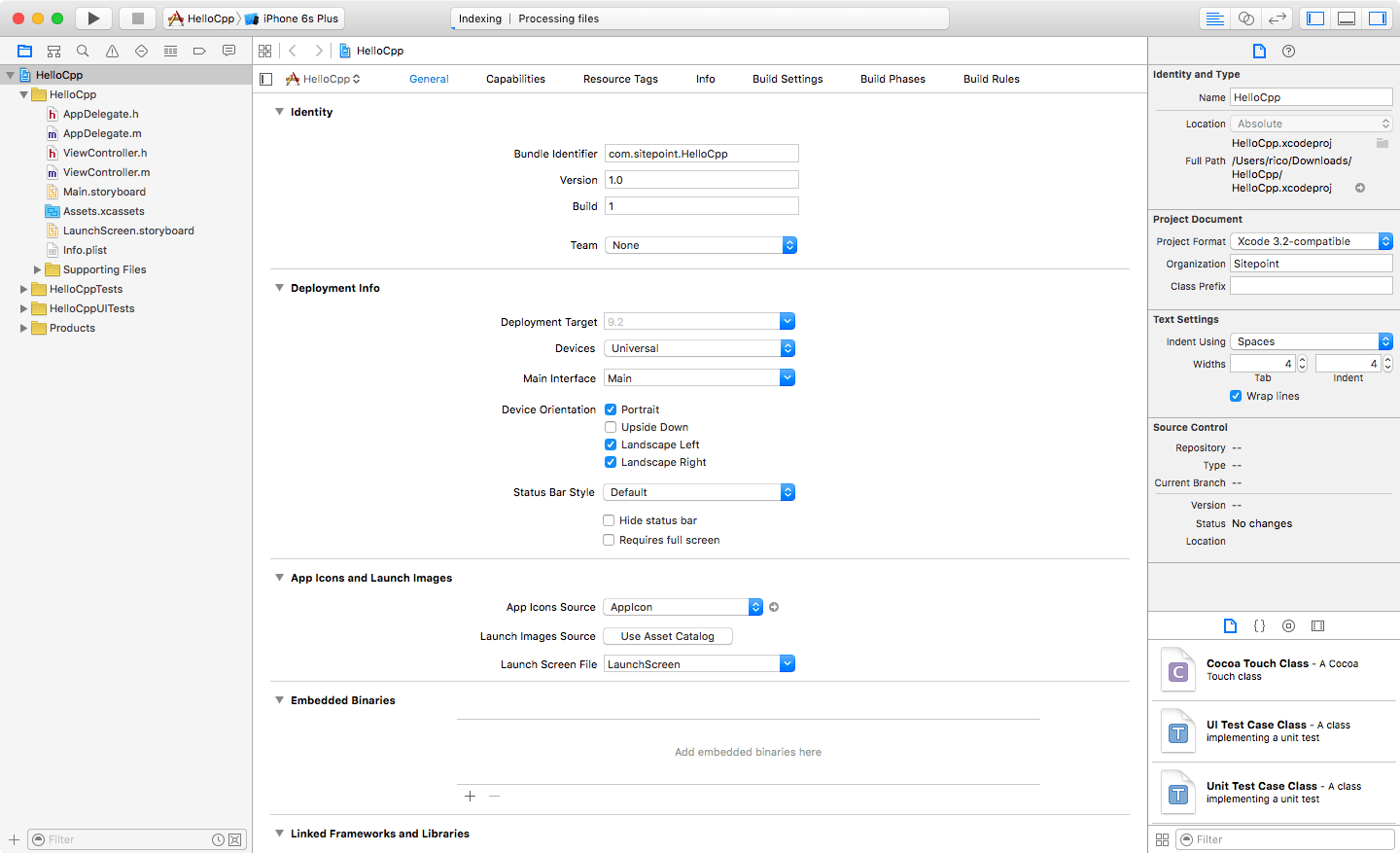
Open Greeting.hpp and add the following code between the include <stdio.h> and #endif /* Greeting_hpp */ lines:
#include <string>
class Greeting {
std::string greeting;
public:
Greeting();
std::string greet();
};Define these methods in Greeting.cpp by adding the following code after the include "Greeting.hpp" line:
Greeting::Greeting() {
greeting = "Hello C++!";
}
std::string Greeting::greet() {
return greeting;
}This is simple code that creates a class named Greeting with a single method named greet() that returns a string value.
Objective-C with C++
Now that you’ve added the simple C++ Greeting class, try calling this from Objective-C. Open ViewController.m and import the Greeting.hpp header file:
#import "ViewController.h"
#import "Greeting.hpp"
...Declare a variable of type Greeting inside the ViewController’s @interface block.
@interface ViewController ()
{
Greeting greeting;
}
@end
If the Show live issues option is enabled, an error saying Unknown type name ‘Greeting’
will instantly appear after adding the previous line of code. To fix this issue, rename ViewController.m to ViewController.mm. This simple naming convention tells Xcode that ViewController wants to mix Objective-C with C++. After renaming the file, the error should disappear.
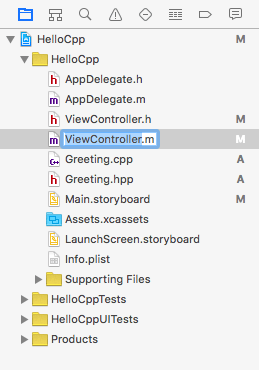
Let’s make the app more interactive by adding a button. Select Main.storyboard from the Project Navigator to show the View Controller scene. Drag a button from the Object Library to the center of the view as shown below. Change the text to Tap Me!.
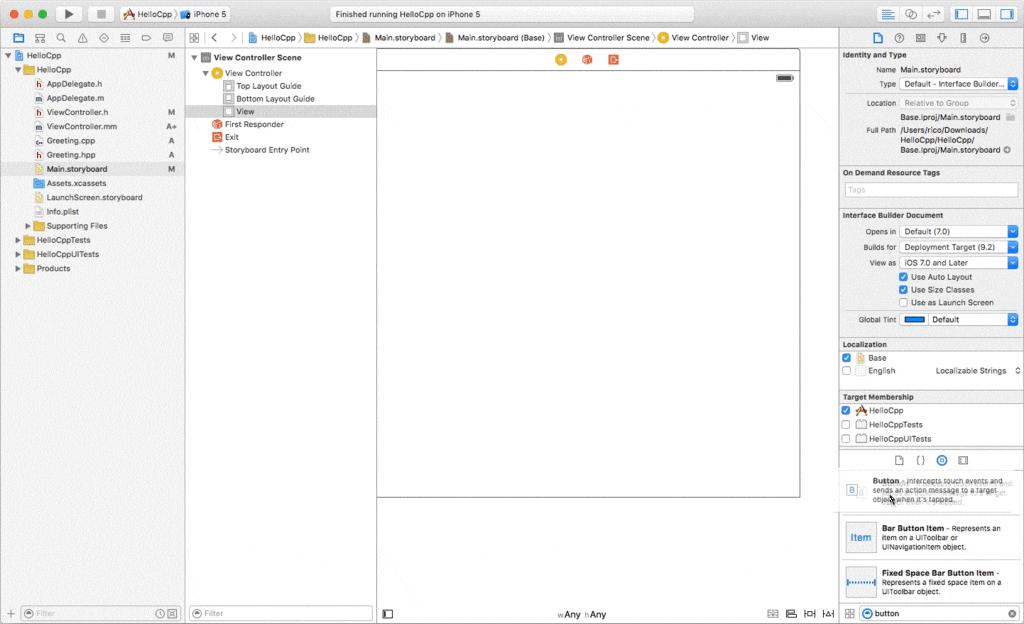
Create a UIButton outlet that points to the recently created button. While still in the Main.storyboard screen, open the Assistant Editor by toggling it from the toolbar. Press the control key on the keyboard and drag a connector from the button to a line below the greeting variable. Name this outlet helloButton.
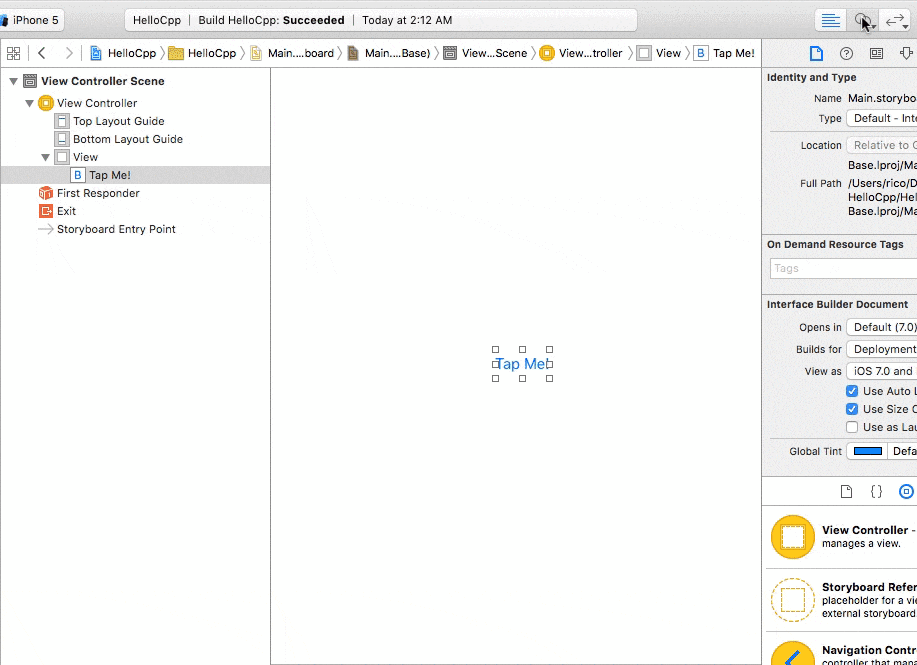
Open ViewController.h and add the following IBAction method between @interface and @end:
- (IBAction)showGreeting;Define this method in ViewController.mm with the following code inserted after the - (void)didReceiveMemoryWarning function and before @end:
- (IBAction)showGreeting {
NSString* newTitle = [NSString stringWithCString:greeting.greet().c_str() encoding:[NSString defaultCStringEncoding]];
[helloButton setTitle:newTitle forState:UIControlStateNormal];
}This method calls the greet() method defined in the C++ class Greeting and uses the string value it returns to replace the Tap Me! button’s title. Connect the button to this action using the same control + drag technique. Go back to the Main.storyboard screen and open the Assistant Editor via the toolbar then control + drag a connector from the button to the - (IBAction)showGreeting method’s body. The small hollow circle on the left of the - (IBAction)showGreeting method should be activated/filled indicating that the Tap Me! button is now connected to that action.
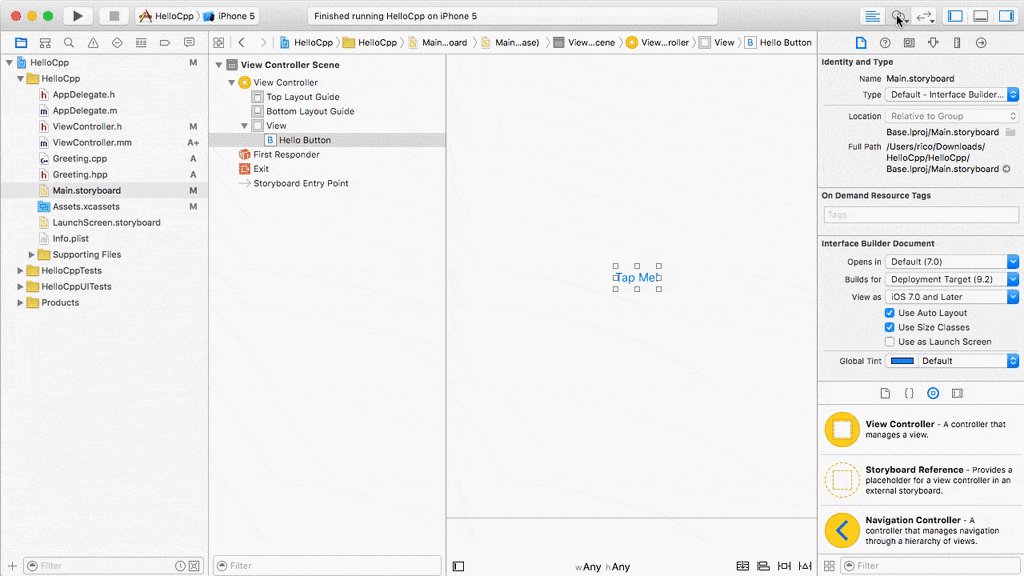
Build and run the app. Notice that the button appears off-center on the simulator. Fix this by enabling Auto Layout constraints using the Control + drag technique. Connect the button to its container and enable both vertical and horizontal centering. Run the app again to see the improvements.
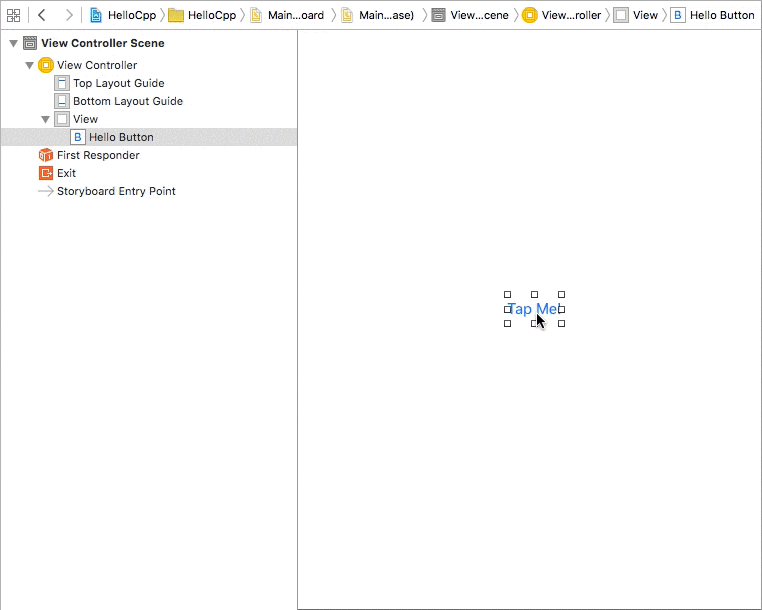
Limitations
Objective-C++ doesn’t actually merge Objective-C with C++ features. Meaning, Objective-C classes won’t have features that are available to C++ and vice versa. The following code examples illustrate these limitations:
Calling a C++ Object Using Objective-C Syntax Will Not Work
std::string greet = [greeting greet]; // errorConstructors or Destructors Cannot Be Added to an Objective-C Object
@interface ViewController ()
{
Greeting greeting;
IBOutlet UIButton *helloButton;
ViewController(); // error
~ViewController(); // error
}
@endThe keywords this and self Cannot Be Used Interchangeably
std::string greet = self->greeting.greet(); // works
std::string greet2 = this->greeting.greet(); // errorA C++ Class Cannot Inherit from an Objective-C Class
#include <stdio.h>
#include <string>
#include "ViewController.h"
class Greeting: public ViewController { // error
std::string greeting;
public:
Greeting();
std::string greet();
};An Objective-C Class Cannot Inherit from a C++ Class
#import "Greeting.hpp"
@interface Goodbye : Greeting // error
@endException Handling Is Also Not Fully Supported When Mixing Objective-C and C++
An exception thrown in Objective-C code cannot be caught in C++ code while an exception thrown in C++ code cannot be caught in Objective-C code.
double divide(int dividend, int divisor) {
if ( divisor == 0 ) {
throw "Cannot divide by zero!"; // will not be caught in Objective-C
}
return (dividend/divisor);
}Reusing Libraries
The ability to reuse existing C/C++ libraries is one of the most important use cases in considering native languages and it’s a straightforward process in iOS. While Android still requires a separate NDK, iOS already supports C and C++.
SDL
As with the Android NDK tutorial, we’ll use SDL in this example. The Simple DirectMedia Layer is an open source hardware abstraction library used primarily for games or anything that involves high-performance graphics. It’s written in C so can be easily included in Objective-C code.
Project Setup
First download the SDL source from the download page or clone the Mercurial repo with:
hg clone http://hg.libsdl.org/SDL
After the download or clone has finished, create a new Single View Application project in Xcode. Name it HelloSDL with the language set to Objective-C.
You’ll be starting from scratch so in the Project Navigator, select the following highlighted files and move them to the trash:
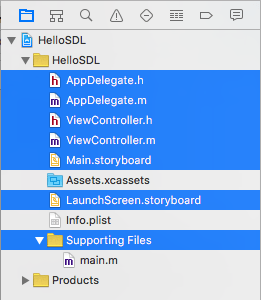
Remove the following keys from the Info.plist file.
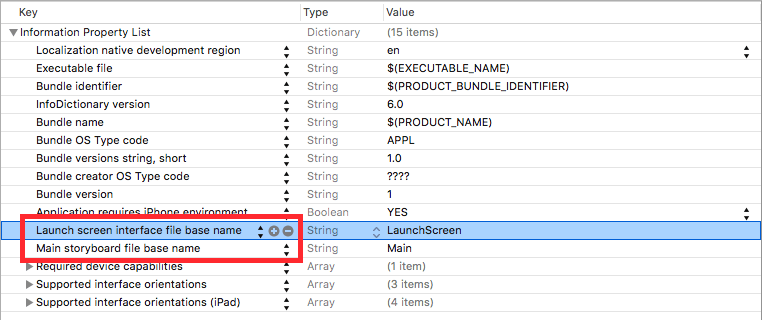
Add the SDL Library project to HelloSDL using the File -> Add Files to Hello SDL
… menu item. Navigate to the downloaded or cloned SDL folder, into Xcode-iOS/SDL/ and then choose SDL.xcodeproj.
Select the main HelloSDL project in the Project Navigator and under the Targets, select HelloSDL. Scroll down to the Linked Frameworks and Libraries section.
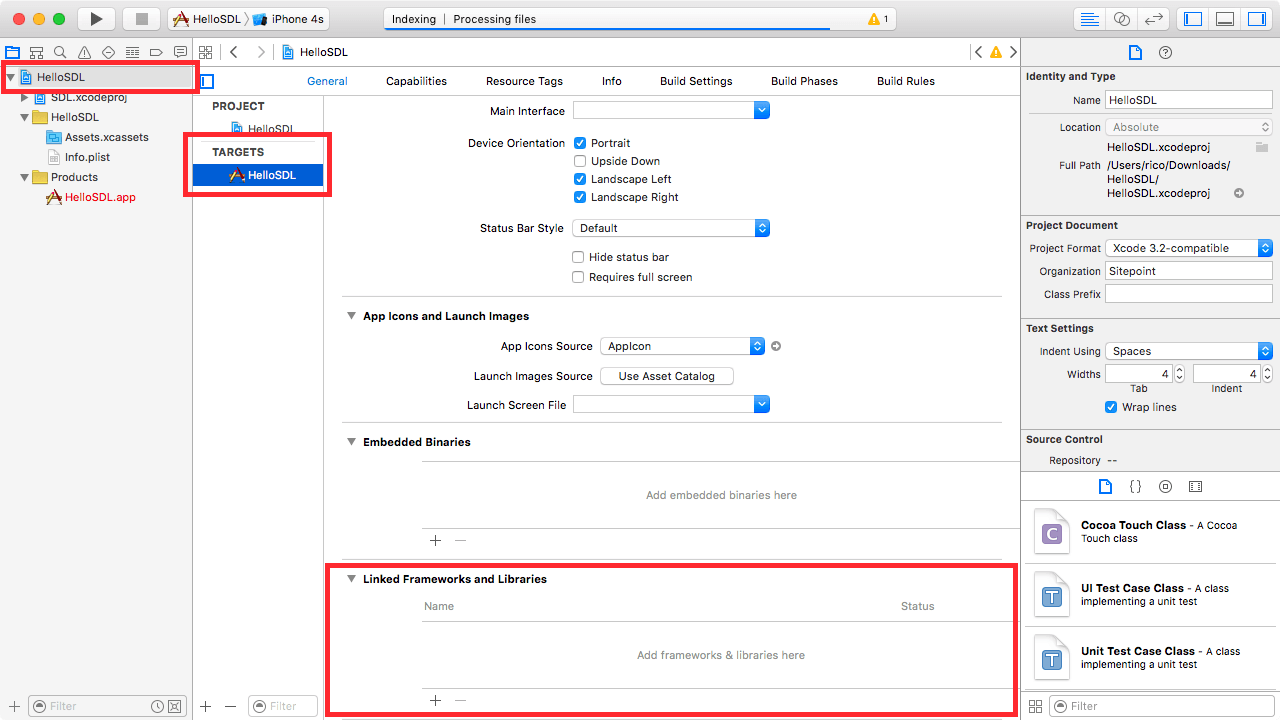
Click the + button to manually add libSDL2.a and the following frameworks:
- AudioToolbox.framework
- CoreAudio.framework
- CoreGraphics.framework
- CoreMotion.framework
- Foundation.framework
- GameController.framework
- OpenGLES.framework
- QuartzCore.framework
- UIKit.framework
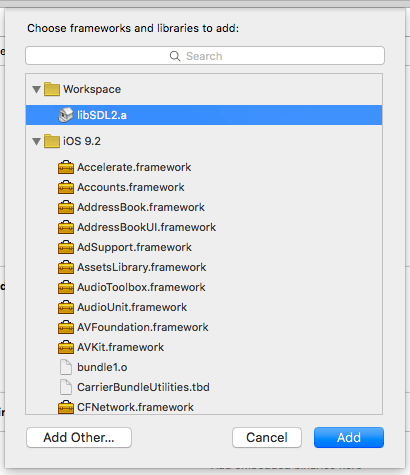
Use Command+Click to multi select the frameworks. Tidy up the Project Navigator by selecting the newly added frameworks and grouping them using the New Group from Selection contextual menu item.
Add a main.c file to the project. No need to create a header file for this one so uncheck the Also create a header file box.
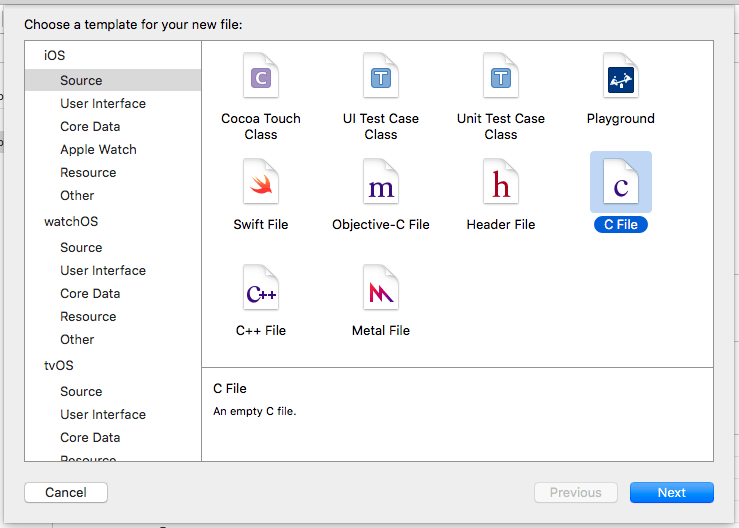
We’ll reuse this sample code by Holmes Futrell from the SDL/Xcode-iOS/Template/SDL iOS Application/main.c file:
/*
* rectangles.c
* written by Holmes Futrell
* use however you want
*/
#include "SDL.h"
#include <time.h>
#define SCREEN_WIDTH 320
#define SCREEN_HEIGHT 480
int
randomInt(int min, int max)
{
return min + rand() % (max - min + 1);
}
void
render(SDL_Renderer *renderer)
{
Uint8 r, g, b;
/* Clear the screen */
SDL_SetRenderDrawColor(renderer, 0, 0, 0, 255);
SDL_RenderClear(renderer);
/* Come up with a random rectangle */
SDL_Rect rect;
rect.w = randomInt(64, 128);
rect.h = randomInt(64, 128);
rect.x = randomInt(0, SCREEN_WIDTH);
rect.y = randomInt(0, SCREEN_HEIGHT);
/* Come up with a random color */
r = randomInt(50, 255);
g = randomInt(50, 255);
b = randomInt(50, 255);
SDL_SetRenderDrawColor(renderer, r, g, b, 255);
/* Fill the rectangle in the color */
SDL_RenderFillRect(renderer, &rect);
/* update screen */
SDL_RenderPresent(renderer);
}
int
main(int argc, char *argv[])
{
SDL_Window *window;
SDL_Renderer *renderer;
int done;
SDL_Event event;
/* initialize SDL */
if (SDL_Init(SDL_INIT_VIDEO) < 0) {
printf("Could not initialize SDL\n");
return 1;
}
/* seed random number generator */
srand(time(NULL));
/* create window and renderer */
window =
SDL_CreateWindow(NULL, 0, 0, SCREEN_WIDTH, SCREEN_HEIGHT,
SDL_WINDOW_OPENGL);
if (!window) {
printf("Could not initialize Window\n");
return 1;
}
renderer = SDL_CreateRenderer(window, -1, 0);
if (!renderer) {
printf("Could not create renderer\n");
return 1;
}
/* Enter render loop, waiting for user to quit */
done = 0;
while (!done) {
while (SDL_PollEvent(&event)) {
if (event.type == SDL_QUIT) {
done = 1;
}
}
render(renderer);
SDL_Delay(1);
}
/* shutdown SDL */
SDL_Quit();
return 0;
}This code displays rectangles with random colors on random areas of the screen. Copy this code to the main.c file.
Finally, set the User Header Search Paths property to the folder where the SDL header files are located. The easiest way to do this is to create a symbolic link that points to the SDL folder inside the HelloSDL project and setting the User Header Search Paths property to SDL/include/.
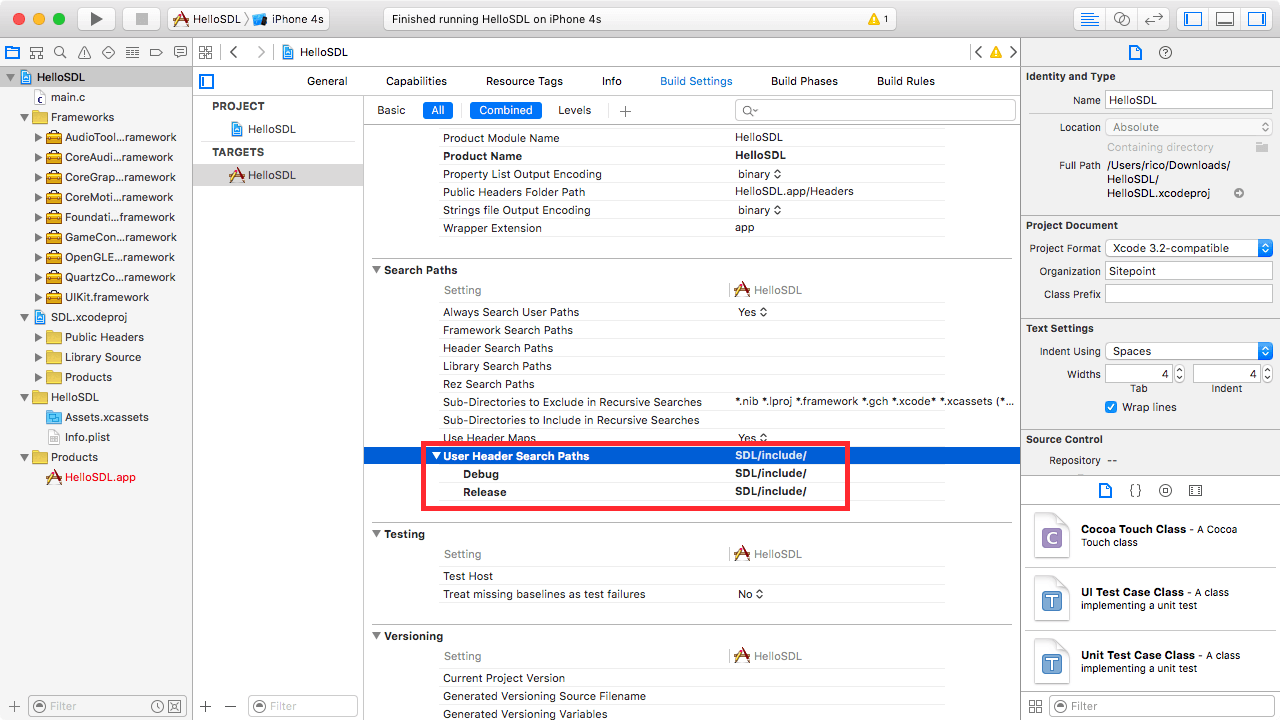
Make sure HelloSDL is the active scheme in the toolbar then build and run the project to see the dancing rectangles.
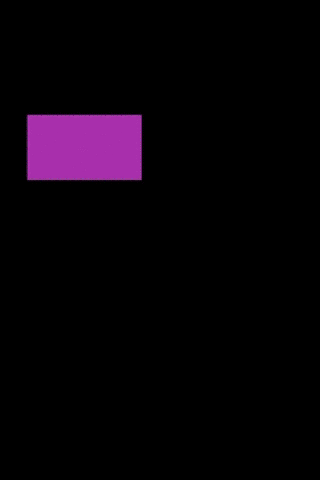
Conclusion
As you have seen, C and C++ development in iOS is straightforward through the use of Objective-C++. If you’ve been programming with C or C++ before then it’s easier now to transition to iOS development and leverage your existing skills. Best of all, you can take advantage of existing C/C++ libraries like the powerful SDL with minimal configuration.
I’d love to hear your experiences and opinions on using Objective-C++ in the comments below.
Frequently Asked Questions (FAQs) about Using C and C++ in an iOS App with Objective-C
What are the key differences between Objective-C and C++?
Objective-C and C++ are both powerful programming languages, but they have some key differences. Objective-C is a superset of the C programming language and provides object-oriented capabilities and a dynamic runtime. It is primarily used for developing software for iOS and macOS. On the other hand, C++ is a statically typed, compiled, general-purpose, case-sensitive, free-form programming language that supports procedural, object-oriented, and generic programming. It is widely used for system/software development and game programming.
How can I integrate C++ code into an Objective-C iOS application?
To integrate C++ code into an Objective-C iOS application, you can use Objective-C++, a language variant accepted by the front-end of the GCC and Clang compilers. Objective-C++ is a language variant that allows you to mix C++ and Objective-C code within the same source file. To use Objective-C++, rename your .m files (Objective-C implementation files) to .mm (Objective-C++ implementation files). This will allow the compiler to recognize that it needs to compile both Objective-C and C++ code.
What are the benefits of using C++ in an iOS app with Objective-C?
Using C++ in an iOS app with Objective-C can provide several benefits. C++ allows for more control over the hardware, which can lead to performance improvements. It also supports a wide range of programming styles, including procedural, object-oriented, and generic programming. This flexibility can make it easier to write complex applications. Additionally, C++ has a large standard library that includes powerful features like complex mathematical operations and file handling.
Can I use C libraries in an Objective-C program?
Yes, you can use C libraries in an Objective-C program. Objective-C is a superset of C, which means that any valid C code should run within an Objective-C program. To use a C library, you simply need to include the appropriate header file and link against the library in your project.
What are the challenges of using C++ in an iOS app with Objective-C?
While using C++ in an iOS app with Objective-C can provide several benefits, it also comes with some challenges. One of the main challenges is that C++ and Objective-C have different syntax and semantics, which can make it difficult to integrate the two languages. Additionally, C++ does not have native support for Objective-C’s dynamic messaging system, which can limit its functionality in an iOS app.
How can I handle exceptions in Objective-C and C++?
Objective-C and C++ handle exceptions differently. In Objective-C, you use the @try, @catch, and @finally directives to work with exceptions. In C++, you use the try, catch, and throw keywords. When integrating C++ and Objective-C, it’s important to note that C++ exceptions cannot be caught in Objective-C code, and vice versa. Therefore, you need to ensure that exceptions are caught in the same language that they are thrown.
Can I use C++ libraries in an Objective-C program?
Yes, you can use C++ libraries in an Objective-C program. To do this, you need to use Objective-C++, which allows you to mix C++ and Objective-C code within the same source file. Once you’ve set up your project to use Objective-C++, you can include C++ headers and use C++ classes and functions in your Objective-C code.
How can I debug C++ code in an iOS app with Objective-C?
Debugging C++ code in an iOS app with Objective-C is similar to debugging regular Objective-C code. You can use the Xcode debugger, which provides a powerful interface for setting breakpoints, inspecting variables, and stepping through code. You can also use the LLDB debugger, which provides a command-line interface and supports a wide range of debugging commands.
Can I use C++ templates in an Objective-C program?
Yes, you can use C++ templates in an Objective-C program. To do this, you need to use Objective-C++, which allows you to mix C++ and Objective-C code within the same source file. Once you’ve set up your project to use Objective-C++, you can include C++ headers and use C++ templates in your Objective-C code.
How can I optimize C++ code in an iOS app with Objective-C?
Optimizing C++ code in an iOS app with Objective-C involves a combination of general C++ optimization techniques and specific strategies for iOS development. Some general techniques include using const references, minimizing copying, and using efficient algorithms and data structures. For iOS-specific strategies, you can take advantage of the powerful hardware and software optimizations provided by the platform, such as the Accelerate framework for high-performance computations.
 Rico Zuñiga
Rico Zuñiga17+ years in the software industry. Experienced CTO in blockchain and cryptocurrency. Community leader, developer advocate, mentor, entrepreneur, and lifelong learner.

